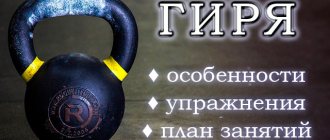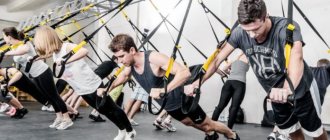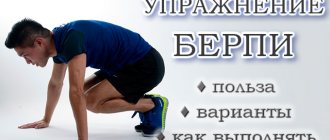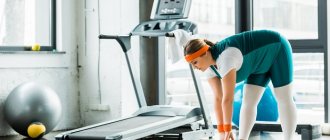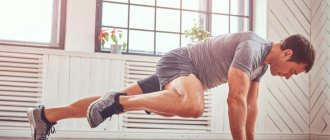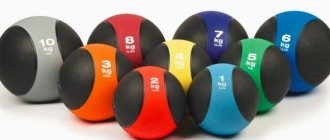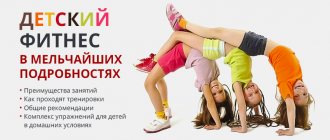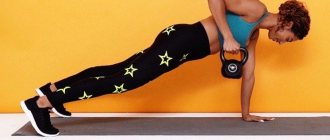A kettlebell is a sports equipment for strength and cardio training, made in the shape of a sphere with a cast handle. Exercises with a kettlebell have their own characteristics and differ from the more familiar exercises with dumbbells.
We offer you detailed material about the advantages and disadvantages of training with a kettlebell, as well as a selection of effective exercises with a kettlebell for strengthening muscles and burning fat.
Kettlebell: what is it for and effectiveness
Kettlebell exercises are designed to train the entire body, developing functional strength, agility and endurance. Kettlebell training simultaneously provides strength and cardio, so with the help of this equipment you can strengthen muscles, burn fat and improve body contour.
Kettlebell training develops strength, endurance, agility and balance while challenging both your muscles and aerobic endurance. The birth of kettlebell lifting dates back to 1885, while Russia is considered the country of origin of this sports equipment. For example, in Spanish the kettlebell is called “pesa rusa” (literally “Russian weight”). In English, a kettlebell is called a kettlebell because it is shaped like a teapot.
Now kettlebell lifting has become widespread all over the world, but it is especially popular in the USA. Kettlebells are used by American athletes in both team and Olympic sports. Kettlebell exercises are often found in CrossFit and other ultra-intensive group programs. For example, Chris Hemsworth used weights in preparation for filming the movie Thor.
Features of kettlebell training
Kettlebell training is equally suitable for both men and women. Exercises with weights are especially often used in such areas as:
- high intensity interval training
- cardio training
- crossfit
- Tabata workouts
- team sports
Do not confuse kettlebell training with classic strength training for muscle growth. During a kettlebell exercise, you'll be focusing on the movements, not the muscles. Kettlebell training develops your functional strength, that is, it is more aimed at teaching motor actions and developing physical qualities: strength, endurance, flexibility, speed and coordination abilities. This sports equipment is great not only for training in the gym, but also for training at home.
Kettlebell exercises are generally not intended for bodybuilding or anabolic training. Kettlebell lifting helps accelerate muscle growth and shift stagnation in strength training, but it has virtually no effect on muscle growth. Basic exercises with a kettlebell do not involve an isolating load; they are aimed at improving functional fitness and explosive strength. Therefore, training with a kettlebell is more suitable for those who want to lose weight, get rid of excess fat, accelerate muscle growth, and move the plateau in strength training.
What muscles work during kettlebell training?
During exercises with a kettlebell, large muscle groups are included in the work as much as possible: the back and legs. The muscles of the arms and shoulders, chest, buttocks, and abs also work. Kettlebell training is ideal for general fitness; basic kettlebell exercises help develop all major muscle groups at the same time. You can use a kettlebell for isolation exercises instead of dumbbells, but the true purpose of the kettlebell is still a full-body workout.
Anyone who has worked out with a kettlebell at least once could feel the peculiarity of the load during the exercises. The unusual shape of the kettlebell works the stabilizer muscles, working them through a wide range of motion. For example, exercises with dumbbells and barbells affect the stabilizing muscles to a much lesser extent. Weak stabilizer muscles cause poor posture, as well as discomfort and pain in the neck, back and lower back. This is due to the fact that the back muscles are not able to properly support the spine.
So, during training with kettlebells they work especially actively:
- leg muscles (quadriceps and adductors)
- muscles of the back of the body (back, lower back, buttocks, hamstrings)
- core muscles (abdominal muscles and stabilizer muscles)
- shoulder girdle muscles
In order for a kettlebell workout to be effective, it is very important to learn how to evenly distribute the load between the muscles of the back and legs. Many people make the mistake during kettlebell training by working intensively with their back and arms, without including their legs, the strongest muscle group, in the work. This will not only reduce the effectiveness of your workouts, but can also lead to a back injury. It is the muscles of the thighs and buttocks that should provide the impulse for swinging and pushing movements, and not the muscles of the arms.
Are kettlebells effective for weight loss and muscle growth?
In one of the American studies on kettlebell training, an experiment was conducted in which they revealed the high energy consumption of exercises with a kettlebell. It has been found that when performing exercises with a kettlebell, on average, you burn about 20 kcal per minute or 1200 kcal per hour of training! The researchers explained this fact by the fact that during kettlebell training, a large number of muscles are used, and also the high tempo at which kettlebell exercises are performed is maintained.
Therefore, training with kettlebells is very effective for losing weight and burning fat. If you want to reduce your fat percentage and strengthen your muscles, you can do kettlebell training 2-4 times a week for 20-45 minutes. Since kettlebell lifting already involves cardio and strength training, you don’t have to add other classes to your plan.
But for muscle growth, training with kettlebells is not the best option. Kettlebell exercises help develop functional fitness and explosive strength, but for muscle growth it is better to use dumbbells and barbells. However, kettlebell exercises can help you avoid strength training plateaus and speed up muscle growth, so you can incorporate kettlebell training into your routine every 7-10 days.
Benefits of training with kettlebells:
- Kettlebell training combines cardio and strength training, which means you will train less, but more effectively.
- The kettlebell allows you to work efficiently on all muscle groups without exception: shoulders, arms, chest, back, abs, buttocks, legs.
- Exercises with kettlebells perfectly train the heart muscle and develop endurance.
- This is a fairly durable and wear-resistant projectile that will serve you for a very long time, unlike expanders, for example.
- Kettlebell training helps build a lean, muscular body with toned muscles and minimal body fat.
- Exercises with kettlebells involve a large number of muscles throughout the body at the same time, which means you can get in shape as quickly as possible.
- Kettlebell training helps strengthen the muscular corset, which stabilizes your spine.
- Exercises with kettlebells are aimed at developing agility, speed, and coordination, which is why they are so popular in crossfit and team sports.
- Kettlebell exercises strengthen tendons and ligaments, making joints stronger and less susceptible to injury.
- The kettlebell helps improve mobility and range of motion without static positions or prolonged stretching.
Disadvantages of training with kettlebells:
- The kettlebell is not the most effective tool for working on muscle growth.
- High risk of injury, especially for those just starting to play sports.
- Exercises with kettlebells put stress on your back, which can lead to spinal problems.
- High-quality weights made of durable materials are quite expensive.
Kettlebell training is not recommended for those who have problems with the cardiovascular system, musculoskeletal system, injuries or recent surgeries. Before starting training with kettlebells, be sure to familiarize yourself with the correct technique for performing the exercises, and if necessary, consult a doctor.
Swing
In kettlebell training, it all starts with a swing (or just a swing). Most experienced athletes usually started like this - with swings and swings. These exercises involve almost all muscle groups due to the active shift of the center of gravity, but the back, shoulders and legs work the most during the swing.
How to do:
To begin, you need to spread your legs a little further than shoulder width, squat down a little, lean forward and grab the weight with both hands. Then you need to rise up with your back bent, lift the weight off the floor and slightly succumb to its inertia.
Afterwards, you need to slowly straighten your back and swing the projectile to chest level. Afterwards you need to lower it down and repeat.
For the first time, it will be enough to do two sets of 15 repetitions.
Ready-made kettlebell lesson plan
We offer you a ready-made workout plan with kettlebells: for the upper body, for the lower body, for the abs and for the whole body. If you want to work on muscle mass, then perform no more than 15 repetitions with the maximum possible weight. If you want to work on fat burning and definition, then perform exercises for 15-20 repetitions with a medium weight.
If you set aside one day for kettlebell training and plan to train the whole body, you can perform all the suggested exercises in one approach. If you train the upper and lower body separately, you can perform each exercise in several approaches or repeat the exercises sequentially in several circles.
Kettlebell exercises for the upper body:
- Overhead kettlebell rotation: 15-20 reps
- Kettlebell Press: 10-15 reps (each arm)
- Kettlebell Rows for Back: 10-15 reps (each arm)
- Casting: 10-15 reps (each hand)
- Kettlebell Pull to Chest: 15-20 reps
- Push-ups: 10-20 reps (can be done from the knees)
- Kettlebell pullover for triceps: 10-20 reps
Abdominal exercises with kettlebells:
- Mill: 10-15 reps
- Russian twist with kettlebell for abs: 10-15 reps (each side)
- Horizontal running: 20-25 reps (each side)
- Rotation of the kettlebell around the body: 10-15 repetitions (each direction)
- Abdominal sit-ups: 10-15 reps
- Side plank: 30 seconds (each side)
Kettlebell exercises for the lower body:
- Kettlebell Chest Squat: 10-20 reps
- Squat with legs raised: 15-20 reps
- Single leg deadlift: 10-20 reps
- Back lunges with weights thrown: 10-15 reps (each leg)
- Jump squats: 15-20 reps
- Combo squat: 10-15 reps
Full body kettlebell exercises:
- Kettlebell Squat: 10-15 reps (each arm)
- One-arm kettlebell push: 10-15 reps (each arm)
- Kettlebell deadlift: 10-20 reps
- Swing: 10-20 reps
- Lateral lunge with kettlebell press: 10-15 reps (each leg)
- Squats + bicep curls: 10-15 reps
- Turkish get up: 5-7 reps
Kettlebell Training Tips
- Be sure to warm up before your workout and cool down after your kettlebell workout. When preparing to perform exercises with a kettlebell, the muscles and ligaments should be well warmed up.
- Choose the weight of the kettlebell based on your strength capabilities: the last repetition in the approach should be performed with maximum effort. You can start training with a 4 kg (for girls) and 8 kg (for men) weights, gradually increasing the weight of the apparatus.
- If you already have sufficient training experience, then the average recommended kettlebell weight for men: 16-24 kg, for women: 8-16 kg.
- During exercises with a kettlebell, keep your back straight and do not slouch. During squats, move your pelvis back to protect your lower back from injury.
- Try to keep your hands in a neutral position, without any bending. You can use special wrist braces to help you support your joints.
- Perform each exercise slowly while maintaining complete control. Do not swing the weight and perform exercises quickly and at speed. Proper exercise form is the most important thing in kettlebell training.
- If you are working on muscle growth, you should not do kettlebell exercises more than once a week. Kettlebell training allows you to develop endurance and explosive muscle strength, which will help move the plateau and provoke muscle growth. But for anabolic training it is better to use dumbbells and a barbell.
- If you have two kettlebells available, you can perform exercises using both kettlebells at the same time. Please note that in this case the kettlebells must be the same size to avoid imbalance in muscle development. Examples of exercises:
Shoes for training
Most athletes, bodybuilders in the gym, wear shoes that are not at all suitable for weight training. You need good shoes that are comfortable and safe. The ankle must be clearly fixed to avoid various sprains when performing heavy squats, leg presses, etc.
In addition, the non-slip surface of the sole and high sides of the shoes will also help you avoid all kinds of ankle injuries. Currently, the choice of inexpensive, up to $100, specialized shoes for bodybuilding is enormous.
Manufacturers are striving to more and more protect the athlete from injury; you just need to enter a query into the search engine “shoes for bodybuilding”, and you can easily find the pair of shoes you need for working out in the gym.
How to choose kettlebells
Whereas previously kettlebells were sold in weights of 4 kg, 16 kg, 24 kg and 32 kg, now you can find almost any kettlebell weight you want. The greater the weight of the weight, the higher its cost. Depending on the material used, weights are divided into plastic, neoprene, cast iron and steel.
Plastic weights
Ideal for training at home, they do not create much noise when colliding with a surface, and the furniture and floor will remain safe and sound. The downside of plastic weights is that their service life is shorter compared to, for example, cast iron or steel. Although if you buy plastic weights from trusted brands, they will last you a long time.
Cast iron weights
These weights are worth choosing for those who value reliable quality. Cast iron weights have high anti-corrosion properties, they are time-tested and will serve you for a long time. But if used carelessly, cast iron weights can scratch the floor or even cause injury to the user.
Steel weights
Weights made of chrome steel have a pleasant appearance and reliable construction. In addition, such weights are also available with a collapsible design, which is very convenient from the point of view of weight regulation. The price of steel weights is slightly higher.
Neoprene weights
The special feature of this type of weights is the soft neoprene coating. Such weights are not so often found on the market, but they are quite practical and safe. Especially suitable for beginners.
Plastic and neoprene weights are safer to use, they are better suited for home use and are cheaper. Cast iron and steel weights generally last longer and are more reliable over long periods of use.
If you are planning to purchase all-metal weights, it is better to get one that is covered with a rubber or vinyl coating to avoid scratching the floor and not creating too much noise. Weights are filled mainly with sand, cement and metal shavings.
Mill
Another effective exercise with a kettlebell is the classic mill. It also strengthens the muscles of the arms, back and abs.
How to do:
Place your feet shoulder-width apart, grab the apparatus with one hand and get ready to stretch it vertically, leaning your torso to the right or left. In this case, you need to touch the floor with your free hand.
After touching the floor with your hand, straighten up, leaving your hand with the weight in the same vertical position, and then bend again to one side. After bending a few times, lower the apparatus to the floor and change hands.
Perform two sets of ten repetitions.
